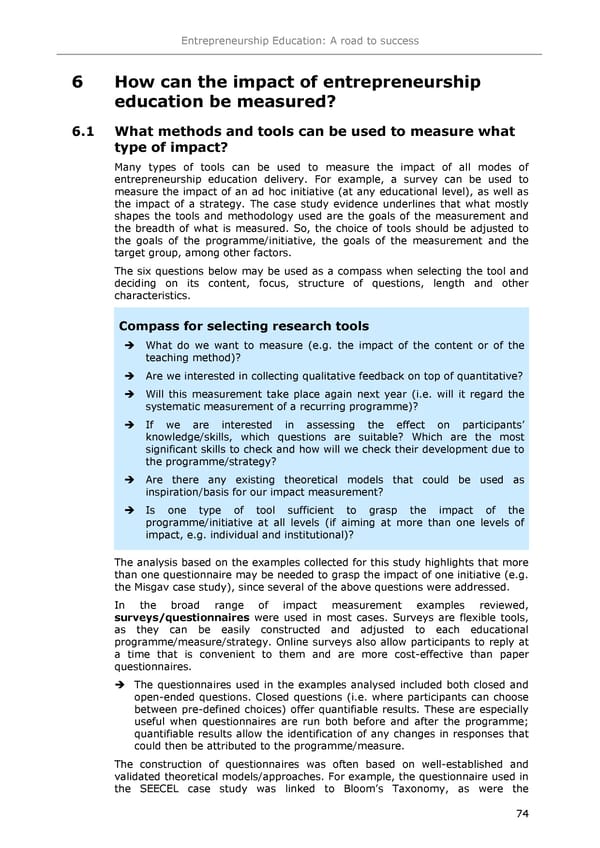Entrepreneurship Education: A road to success 6 How can the impact of entrepreneurship education be measured? 6.1 What methods and tools can be used to measure what type of impact? Many types of tools can be used to measure the impact of all modes of entrepreneurship education delivery. For example, a survey can be used to measure the impact of an ad hoc initiative (at any educational level), as well as the impact of a strategy. The case study evidence underlines that what mostly shapes the tools and methodology used are the goals of the measurement and the breadth of what is measured. So, the choice of tools should be adjusted to the goals of the programme/initiative, the goals of the measurement and the target group, among other factors. The six questions below may be used as a compass when selecting the tool and deciding on its content, focus, structure of questions, length and other characteristics. Compass for selecting research tools What do we want to measure (e.g. the impact of the content or of the teaching method)? Are we interested in collecting qualitative feedback on top of quantitative? Will this measurement take place again next year (i.e. will it regard the systematic measurement of a recurring programme)? If we are interested in assessing the effect on participants9 knowledge/skills, which questions are suitable? Which are the most significant skills to check and how will we check their development due to the programme/strategy? Are there any existing theoretical models that could be used as inspiration/basis for our impact measurement? Is one type of tool sufficient to grasp the impact of the programme/initiative at all levels (if aiming at more than one levels of impact, e.g. individual and institutional)? The analysis based on the examples collected for this study highlights that more than one questionnaire may be needed to grasp the impact of one initiative (e.g. the Misgav case study), since several of the above questions were addressed. In the broad range of impact measurement examples reviewed, surveys/questionnaires were used in most cases. Surveys are flexible tools, as they can be easily constructed and adjusted to each educational programme/measure/strategy. Online surveys also allow participants to reply at a time that is convenient to them and are more cost-effective than paper questionnaires. The questionnaires used in the examples analysed included both closed and open-ended questions. Closed questions (i.e. where participants can choose between pre-defined choices) offer quantifiable results. These are especially useful when questionnaires are run both before and after the programme; quantifiable results allow the identification of any changes in responses that could then be attributed to the programme/measure. The construction of questionnaires was often based on well-established and validated theoretical models/approaches. For example, the questionnaire used in the SEECEL case study was linked to Bloom9s Taxonomy, as were the 74
 Entrepreneurship Education Page 77 Page 79
Entrepreneurship Education Page 77 Page 79